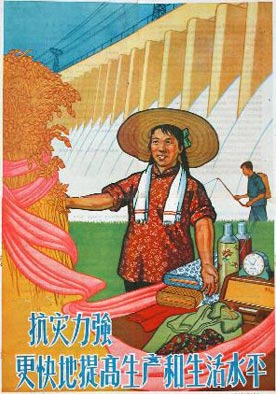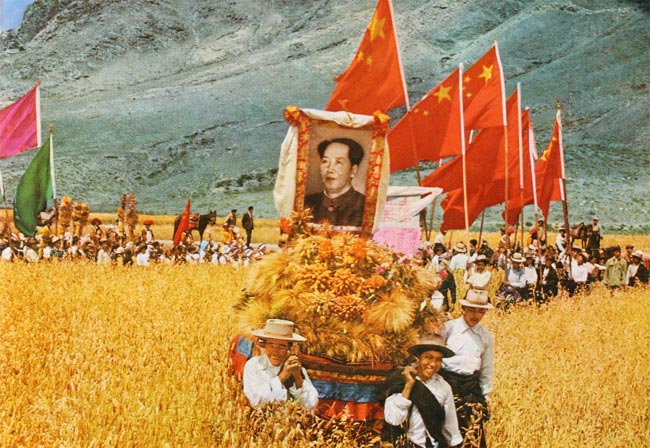The Mao Zedong mentality from the 1950s is that Mother Nature can (and should) be defeated and overcome—and that Red China will surely achieve this. The slogan 'Humans must conquer nature' was widespread under Chairman Mao. Mao's arrogant legacy lingers today with the leadership of the military-industrial-complex that rules China. Over 60 percent of China's current leaders have engineering backgrounds—and vested interests in large engineering companies that need mega-projects to keep going.
There is a contrary viewpoint being spearheaded by the educated elite of Chinese society. This viewpoint is that trying to take on Mother Nature can lead to disaster. This is a Green China movement, pointing to the need to develop 'green energy technology' and pointing to the need to conserve resources and institute sound environmental practices—or risk annihilation at the hands of Mother Nature. Desertification, for instance, is turning large parts of northern China into a parched wasteland.
Revolutionary Red China or revolutionary Green China—which is the way forward?
Red Flag Canal
In the early days of the Mao era, taking on Mother Nature had mixed results. Experiments with eliminating pesky sparrows resulted in a plague of locusts descending. The Great Sparrow Campaign, initiated by Mao Zedong in the late 1950s, was launched because sparrows ate grain seeds and were thought to be detrimental to agriculture. It was decided that all peasants in China would bang pots and pans and run around to make sparrows fly away in fear. Sparrows were killed with slingshots, nests were destroyed, nestlings were killed. In early 1960, the National Academy of Science found that sparrows ate insects more than seeds. By this time, however, it was too late. With no sparrows to eat them, the locust population ballooned, swarming the country and compounding the problems already caused by the Great Leap Forward. This led to a great famine in which millions died of starvation.
But on to the engineering experiments. At the height of Maoist revolutionary fervour in the 1960s, a colossal project called Red Flag Canal was launched by peasants using the most rudimentary of tools. Between 1960 and 1969, more than 100,000 'volunteer' labourers tunnelled through hundreds of kilometres of mountain to divert drinking water from Shanxi province to the parched valleys of Lin County in northern Henan province. This was touted by Mao's propaganda people as a marvel of engineering, and is still held up by the Party as a patriotic model of the Communist spirit.
Red Flag Canal has not fared well with the passage of time. Today, it is little more than a tourist attraction: the water level has dropped as the source river dwindles, much of Lin County has dried up again, and upstream pollution makes the water unpotable. There are bitter disputes between Lin County farmers and those upstream who had their water stolen through diversion (and who now receive compensation from the Lin County government).
Mao Zedong has been credited with envisioning two mega-engineering ideas for the Yangtse. One is a massive dam on the Yangtse—which in 2009 came to reality in the form of the Three Gorges Dam, displacing over a million people. And the other project he envisioned is the massive diversion of water from the Yangtse to northern China. First proposed by Mao Zedong in 1952, the South-to-North Water Transfer Project got under way in 2002, and is expected to take more than 50 years to complete—making it the world's largest hydropower project ever.
Mao's Dams
The following excerpt is from the book, When a Billion Chinese Jump, by Jonathan Watts. He interviewed Chinese dissident Dai Qing, who was thown in jail for 10 months for criticising the Three Gorges Dam project.

1960 poster touts this message —
dams improve agriculture and fight disasters
"Dai told me China had a long history of building dangerous dams and then covering up the consequences. Construction surged in the 1950s. Initially, there was a debate between Daoist and Confucian dam builders. The Daoists preferred to use low levees and the natural flow of the water, as in Dujiangyan, while the Confucians wanted high dykes and other big projects to control the course of rivers. Mao, as we have seen, threw his support behind the latter's mega-projects.
In the fury of dam-building at the start of the Great Leap Forward, Dai said, 580m cubic tons of earth was shifted for barriers and irrigation channels. In one insane year, 1958, that will come up again and again in this book, more than double the amount of earth was moved for hydro-projects than in the whole of the previous decade.
Scrappily built and inadequately checked, many collapsed with deadly consequences. The first big dam to go was at Fushan, which lasted just four months before bursting and drowning 10,000 people downstream. by 1980 2,796 dams had failed with a combined death toll of 240,000. This was not made public until many years later.
But the problems caused by haste, vanity and secrecy remain. 'The crap from that era has not yet been cleaned up,' the former chief engineer of the Water Resources Bureau of Henan province, Ma Shoulong, told Dai. Experiences like this have made her sceptical about President Hu's environmental credentials. 'It's just a show. This is not for the people; it's to paper over the legitimacy problems of the Communist Party. They speak sweet words, but continue to do bad things,' Dai told me. The year 1958 may have been exceptional, but even under the new mantra of sustainability China remains a country of massive and often reckless hydro-ambitions.

Mao's Tibet Disaster
In 1959, in Tibet after the Dalai Lama fled to India, the Chinese enforced new approaches to agriculture. They started up communes on a mass scale, and ordered wheat to be planted instead of barley. No arable land was to be left idle: teams embarked on massive irrigation projects, built dams and reservoirs, and collected waste matter for fertiliser. Propaganda posters from the 1960s show happy smiling Tibetans with bumper harvests—enthusiastically parading around wheatfields with Mao Zedong pictures. But the reality was very different: tens of thousands of Tibetans starved to death. China's disastrous agricultural policies led to severe famine in Tibet. No sooner was Tibet's crop harvested than it was taken by the army or shipped to China. The whole intent of forming communes was to create a bread-basket for the starving People's Republic, which was suffering its own famine—due to similar disastrous policies.
